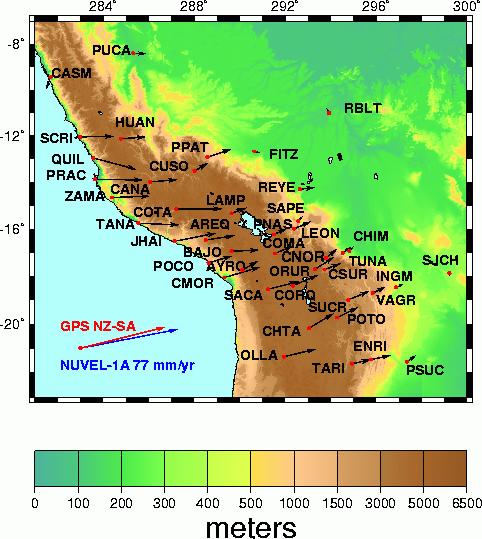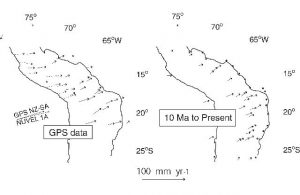“We may confidently come to the conclusion that the forces which slowly and by little starts uplift continents, and those which at sucessive periods pour forth volcanic matter are identical. I believe that the frequent quakings of the earth are caused by the rending of the strata, necessarily consequent on the tension of the land when upraised…” (Darwin, The Voyage of the Beagle)
Since Charles Darwin’s voyage in H.M.S. Beagle in 1832, geologists have marvelled at the great snowy 20,000 foot high peaks of the Andes mountains and wondered how they form. Now, using Global Positioning System (GPS) satellites, scientists can actually watch the mountains grow.
Darwin suspected that the giant mountains, huge volcanoes, and great earthquakes that occur along the Pacific coast of South America were related. In the 1960’s, geologists realized that they all were consequences of the fact that the oceanic Nazca plate is descending (subducting) beneath the South American plate.
To monitor how this happens, scientists from Northwestern, University of Miami, and the Carnegie Institution, together with Peruvian and Bolivian scientists, established a set of benchmarks spanning the Andes. Using radio signals from GPS satellites, these benchmarks can be located to an accuracy of better than an inch, so repeated measurements of the marks shows the GPS sites moving relative to South America. Technical support for the project was provided by engineers from UNAVCO, a national consortium of universities using the Global Positioning System for geological research.
|
|
 |
|
GPS Site motions with respect to the stable South American continent Black arrows show motion of GPS sites with respect to the stable interior of the South American continent. Red arrow shows net motion of the Nazca plate toward South America observed from GPS sites on islands within the Nazca plate. Blue arrow shows motion predicted predicted by global plate motion model NUVEL-1A. Hence plate motions observed over two years with GPS are very similar to those found over three million years (NUVEL-1A). For site velocities and positions, click here.
The measurements show that about 3 inches (78 mm) per year of motion between the Nazca and South American plates occurs, and is split three ways. About 1.3 inches (35 mm) per year occurs as the Nazca plate slides smoothly under South America, giving rise to great volcanoes. About another 1.3 inches (35 mm/yr) per year is locked up at the plate boundary, squeezing South America, and is released every hundred years or so in great earthquakes. The about final half inch (10 mm/yr) per year crumples South America permanently, building the Andes.
What’s happening is like pushing a rug – the rug shortens in folds, and so the folds rise off the floor. A half inch per year doesn’t sound like much – but over 25 million years, it can build giant mountains!
Now that the project, called SNAPP (South America – Nazca Plate motion Project) has accomplished its first goals, we hope to continue the study to get a more detailed picture of the process building mountains, causing the earthquakes, and volcanoes. They can already variations in motion along the Andes mountain chain, showing that chunks of crust are moving slightly sideways as well as being compressed.
These results are some of the many spectacular results now emerging from the use of the Global Positioning System satellites and other space-based techniques to measure positions on the earth far more precisely than would have been dreamed possible a few years ago. Before this, geologists could only study the motion of the great plates of Earth’s lithosphere (which move at speeds of a few inches per year, about the speed fingernails grow) over periods of millions of years, long enough for large motions to accumulate. The very precise positioning now available makes it possible to see plate motions over a period of a year.
The new data can do a great deal. They show in detail how plate motion occurs at the boundary zones between pairs of plates, such as the Andes. We and coworkers Mian Liu of University of Missouri, and David Hindle of Michigan State are combining the GPS data with geological and seismological data to develop models of the mechanics of the plate boundary. We are finding that although transient elastic deformation seen in the GPS data occurs near the trench and in the high Andes, the long-term deformation due to plate convergence and gravitational spreading of the mountains predicts little motion across the Andes but concentrated crustal shortening in the SubAndean fold-and-thrust zone, as observed geologically, seismologically, and in GPS data. Hence the apparent discrepancies between different data reflect the time-dependence of lithospheric rheology. Similarly, the fact that the geodetic shortening rates are approximately an order of magnitude higher than the seismic rates, implying that most of the deformation occurs aseismically.
We have begun extending the present-day results to explore the evolution of the Andes in space and time. We find that the present horizontal shortening shown by the GPS velocity field is quite similar to that for the past 10 Ma constructed from structural data. However, geological shortening vectors for 10-25 Ma are similar in direction, but slower, than the 0 – 10 Ma vectors. Comparing the present plate motion from GPS to that over the past 25 Ma from magnetic data shows that Nazca – South America convergence has slowed steadily. Hence over the past 25 Ma shortening and uplift migrated eastward and accelerated, leaving the Andean plateau behind, even as the convergence causing the uplift slowed. .PP The data are being used, in collaboration with M. Liu of the University of Missouri, to model how subduction of the oceanic Nazca plate beneath continental South America causes crustal shortening and uplift up to 500 km inland from the trench. Three-dimensional viscoelastic finite element modeling of the velocity field shows that although transient elastic deformation seen in the GPS data occurs near the trench and in the high Andes, the long-term deformation due to plate convergence and gravitational spreading of the mountains predicts little motion across the Andes but concentrated crustal shortening in the SubAndean fold-and-thrust zone, as observed geologically, seismologically, and in GPS data. Hence the apparent discrepancies between different data reflect the time-dependence of lithospheric rheology. The corresponding stress field predicts the observed compression in the SubAndean zone, and modest along-strike extension in the high Andes, as observed in earthquake mechanisms and the faulting history. The models can also simulate the temporal variations of topography and shortening along the mountain belt as well as across it.
Although Darwin probably couldn’t have imagined that satellites could prove him right, he certainly would have enjoyed the results.
Results published as:
Leffler, L., A. Mao, T. Dixon, S. Stein, and M. Ellis, Constraints on the present-day shortening rate across the Central Eastern Andes from GPS measurements, Geophys. Res. Lett., 24, 1031-1034, 1997.
Norabuena, E., L. Leffler-Griffin, A. Mao, T. Dixon, S. Stein, I. S. Sacks, L. Ocala, and M. Ellis, Space geodetic observations of Nazca-South America convergence along the Central Andes, Science, 279, 358-362, 1998.
Norabuena, E., T. Dixon, S. Stein, and C. Harrison, Decelerating Nazca-South America Convergence and Nazca-Pacific Spreading, Geophys. Res. Lett., 26, 3405-3408, 1999.
Liu, M., Y. Yang, S. Stein, Y. Zhu, J. Engeln, Crustal shortening in the Andes: Why do GPS rates differ from geological rates? Geophys. Res. Lett., 27, 3005-3008, 2000.
Hindle, D., J. Kley, E. Klosko, S. Stein, T. Dixon, and E. Norabuena, Consistency of geologic and geodetic displacements during Andean orogenesis, Geophys. Res. Lett., 29(7), 10.1029/2001GL013757, 2002.
Liu, M., Y. Yang, S. Stein, and E. Klosko, Crustal shortening and extension in the Andes from a viscoelastic model, in Plate Boundary Zones, edited by S. Stein and J. Freymueller, Geodynamics Series 30, AGU, Washington, D. C., 2002.
Klosko, E., S. Stein, D. Hindle, J. Kley, T. Dixon, E. Norabuena, and M. Liu, Comparison of geodetic, seismological, and geologic observations in in the Nazca-South American plate boundary zone, in Plate Boundary Zones, edited by S. Stein and J. Freymueller, Geodynamics Series 30, AGU, Washington, D. C., 2002.
Yang, Y., M. Liu and S. Stein, A 3-D geodynamic model of lateral crustal flow during Andean mountain building, Geophys. Res. Lett., 30(21), 10.1029/2001GL018308, , 2003.
SNAPP Investigators:
Seth Stein
Department of Earth & Planetary Sciences, Northwestern University
Evanston, Illinois 60208
(847) 491-5265 FAX: (847) 491-8060
http://www.earth.northwestern.edu/people/seth
Tim Dixon and Ailin Mao
Rosenstiel School of Marine and Atmospheric Sciences
University of Miami 4600 Rickenbacker Causeway Miami, FL 33149
Telephone: 305 361 4660 Fax: 305 361 4632
http://www.geodesy.miami.edu/
Selwyn Sacks
Carnegie Institution of Washington
5241 Broad Branch Rd, NW
Washington D.C. 20015
202-686-4310
E. Norabuena and L. Ocola
Instituto Geofisico del Peru
Apartado 3747, Lima 100, Peru
Mian Liu and Y. Yang
Department of Geological Sciences
University of Missouri, Columbia MO
David Hindle
Department of Geological Sciences
Michigan State University, East Lansing, MI



